Sedans used to be the mainstays of the market – mostly on account of their being practical. Four doors instead of two. Then along came crossovers – which are based on sedans, but more practical because they have five doors, taller roofs and more cargo room. Many people also prefer to ride up higher and like that the crossover’s higher ride height (and ground clearance) are helpful when it snows.
This has motivated the people who design sedans to make them more interesting. The question is, how?
Especially if the sedan in question is a modestly priced family sedan.
Honda engineers came up with a couple of things when they set to work on the new Accord sedan.
First, you can get this sedan with a manual transmission – something most rival sedans like the Toyota Camry, Hyundai Sonata and Nissan Altima don’t offer.
Second, you can get the manual with the standard engine and the optional hot engine – something none of the others offer, even the few that still permit you to shift for yourself, like the Mazda6. But only with the standard engine. The Mazda’s hot/optional engine comes only with an automatic.
And it’s more practical than rivals sedans like the Accord, Camry and Mazda6. It’s got a noticeably larger trunk (16.7 cubic feet vs. 14.7 for the Mazda, 15.1 for the Toyota and 15.4 for the Nissan) and a very noticeably roomier back seat (40.4 inches of legroom vs. 37.1 inches in the Altima and Mazda6 and 38 inches in the just-redesigned Camry).
But it has a smaller overall footprint than the previous Accord.
All of which makes it pretty . . . interesting.
WHAT IT IS
The Accord is a mid-sized, front-wheel-drive sedan that competes in the “family car” segment – also occupied by rivals like the Toyota Camry, Mazda6, Chevy Malibu and Hyundai Sonata.
It’s always been one of the sportiest – and most technologically cutting-edge – sedans in the class and for 2018, Honda has doubled-down on both. Mainly because crossovers are replacing sedans as the family cars of choice.
The Accord’s rivals have become sportier, too – even the historically stodgy (but best-selling) Camry.
It makes sense.
These sedans can’t compete with crossovers on utilitarian grounds. So why not make them sexier, more fun to drive?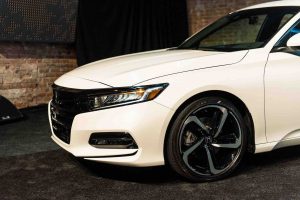
Not everyone needs a huge cargo area, after all.
Prices start at $23,750 for the base LX trim – powered (for the first time in an Accord) by a turbocharged 1.5 liter engine paired up with a continuously variable (CVT) automatic transmission. If you want something a little . . . sportier, you can switch out the CVT automatic in favor of a six-speed manual transmission in the . . . Sport trim.
This one stickers for $25,780.
And if you want something sportier still, there’s a turbocharged upgrade – a larger/stronger 2.0 liter engine that you can also get with a manual transmission.
Base price for the 2.0/manual-equipped Accord is $30,310.
A top-of-the-line Touring trim with the 2.0 engine paired up with a ten-speed automatic transmission stickers for $35,800.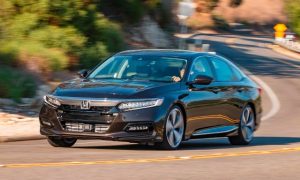
You can also get the Accord in coupe – and hybrid sedan – forms. These will be reviewed separately.
WHAT’S NEW
The whole car.
Major changes include a roomier cabin – particularly the back seat – and the adoption of turbocharged fours in all trims (the formerly optional V6 has been dropped).
The exterior sheetmetal is (cue Dr. Evil voice) laser-brazed, which nearly eliminates obvious seams, giving the body an ingot-like, one-piece appearance. Shorter overhangs and a longer wheelbase make it look like a bigger car – but it’s actually slightly more compact in terms of its exterior footprint, so it’s easier to park and has a tighter turning circle than the previous Accord.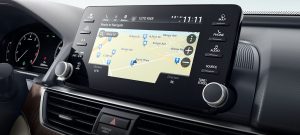
The infotainment also gets upgraded to the latest 4G technolog and there’s a playback function for live satellite radio programming. The available rear seat heaters are three-stage now and heat your back now, too – not just your buns.
WHAT’S GOOD
Much more fun to drive than a crossover.
Crossovers don’t offer manual transmissions.
More backseat and trunk space than others in this class – and neary as much as the next-up (full-size) class.
Much improved outward visibility vs. previous Accord (A pillars at either side of the windsheld are 20 percent narrower).
WHAT’S NOT SO GOOD
Unknown track record for the new turbo engines – and the new ten-speed automatic.
You can still get a V6 in the Camry.
Trunk is larger – but still small vs. a crossover’s cargo area.
Front passenger seat has no height adjustment.
In the ‘70s, it was Disco Fever. Wide collars, bell bottoms and gold chains abounded.
Today, it’s Turbo Fever. Car companies are turning to turbos to keep the power up, while engine displacement goes down. The latter is being done to get more mileage out of engines. The former, to keep the power flowing out of those smaller engines.
So, the ’18 Accord’s standard engine shrinks from 2.4 liters last year to just 1.5 liters this year. But power goes up to 192 hp (vs. 185 last year) courtesy of the turbocharger that gooses the output of the 1.5 liter engine on demand.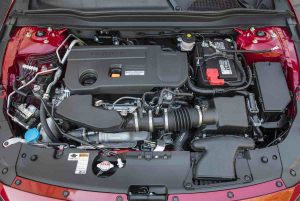
That’s italicized to emphasize the point. The littler engine is capable of higher mileage (30 city, 38 highway with the optional CVT automatic transmission) vs. last year’s larger engine (27 city, 36highway) when maximum power isn’t demanded – but that extra power is always available when the driver does demand it.
Now you know why small, turbocharged engines are replacing bigger engines – in every type of vehicle you can imagine, including even big trucks like the current Ford F-150.
This includes the Accord’s optional engine – which is also a small (comparatively) turbocharged engine. It’s a 2.0 liter four – and it replaces last year’s 3.5 liter V6. It makes a bit less horsepower – 252 vs. 278 for the sent-to-pasture V6. But it makes more torque – 277 ft.-lbs. vs. 252 ft.-lbs. – and that plus some pounds-shedding for the rest of the Accord – which is about 150 pounds lighter than the old model – equates to no loss of quickness (zero to 60 in 5.6 or so seconds, the same as last year’s V6 Accord) with an uptick in mileage.
Paired with the new 10 speed automatic transmission (this is the optional transmission with the 2.0 liter engine) the ’18 Accord’s mileage climbs to 23 city, 34 highway from 21 city, 33 highway for the old V6 paired with a six-speed automatic.
The uptick isn’t much, obviously – but the point is that Honda has maintained the car’s power/performance while doing what it must to squeeze out even slight gains in fuel efficiency to keep the government off its back. Without the on-demand power of turbocharging, we’d be stuck with smaller – more fuel efficient – but much less powerful engines.
But what really separates the Accord from the pack is that both of its turbocharged engines can be paired with manual transmissions. That is no small thing – because the manual versions of both aren’t quite as fuel-efficient as the automatic-equipped versions (CVT and the new ten speed) and that makes it. bold thing for Honda to offer the manuals, since the lower MPG numbers have the potential to decrease their overall “fleet average” numbers – which is how the government decides whether a given car company is “compliant” with its fuel economy fatwas.
Automatics may be slightly more fuel-efficient, they’re s also that much less fun.
Even if you don’t buy a manual-equipped Accord, the fact that you could says a lot about this car – and the attitude of the company that made it so.
Is it better to sit high – or have a more stable-handling ride?
Crossover Mania is driven, in part, by this business about sitting higher up. Fat people – of which there are more than ever – like it because it’s easier for them to get in and out. Others because they can see better – though this is debatable, at least insofar as visibility to the sides and rearward are concerned because of the typical crossover’s Ben Swolo-style B and C pillars, bathtub beltline and Kim Kardashian rear end.
What’s not debatable is that crossovers don’t handle nearly as well as sedans – precisely because they ride high, which puts the weight of the thing (of which there is usually more, vs. a car) up rather than down, which is bad for stability – especially during sudden maneuvers, as when the wheel is jerked hard left or right to avoid something in the vehicle’s path.
The new Accord handles particularly well – and not just because it sits closer to the road. Even closer (by 10 mm) than the old Accord, in fact.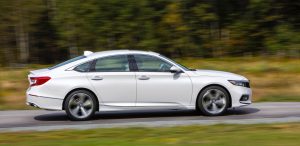
It’s also the first Accord to offer an adaptive suspension – shock damping is tailored automatically in response to changing road/driving conditions. You get more stability control – and a better ride, even when the road isn’t great.
This is a feature many high-end luxury-sport sedans have – but no other sedans in the Accord’s class offer.
The Acccord’s electric power steering system is also worth a mention. It is precise and natural feeling. Many new cars also have electric power steering – because it’s a way to reduce parasitic drag on the engine (which helps boost gas mileage) but most feel electric; the wheels turn, but they don’t feel connected to the wheel.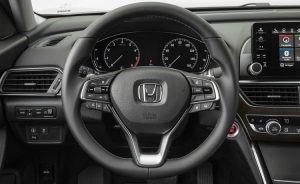
The Accord’s does.
It helps that it’s a fairly small diameter and thickly padded steering wheel, too – the kind of wheel you’d expect to find a Type-R Civic.
Speaking of that.
The Accord’s new 2.0 liter engine is basically a Civic Type R engine, tamed down just a bit. The big difference being the max boost pressure – 20.8 psi vs. 23.2 in the Type R and a peakier powerband. The Type R’s version of the 2.0 liter engine develops its maximum of 306 hp at 7,000 RPM and its peak torque at 2,500 RPM vs. the Accord version’s 6,500 hp peak and 1,500 RPM torque peak.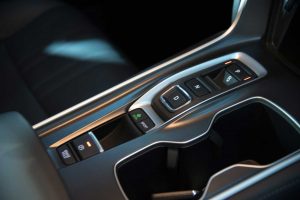
So the engine seems milder – and is, until you want it not to be. The 1,500 RPM torque peak gives you easy pull-away power, very much like you’d get from a larger V6. But the turbo boost also gives you the ability to skitter the tires – to do rolling burnouts – when the mood hits you.
Including in between second and third gear.
There’s an almost afterburner feel to this – a feel made more jet jock via the way you operate the 10-speed automatic. There is neither conventional grab handle nor feel-less rotary knob. Instead – and uniquely Honda – there is a kind of sloped (to fit your hand) mini-console on the center console, with buttons that have tactile feedback. Drive is engaged by depressing (rather than touch-tapping) a button. Reverse, by pulling back on a switch. Each time, your hand interfaces with something tangible, not just electronic. You bond with the car because of things like this.
The top three gears are all overdrive gears – with 10th gear being a 0.527 ratio, effectively cutting the revs by half. It’s such a steep overdrive, the transmission won’t even go there (to avoid lugging the engine) until you’re cruising around 60 or so. But once you are at cruising speed, engine speed will be well under 2,000 RPM – which is how you average close to 30 MPG (28.3 MPG) as I did during a weeklong test drive that included a lot of highway driving at 70-80 MPH.
The reduced engine RPM in top gear also gives a quiet ride – enhanced by acoustically tuned wheels that have a noise-abating strip bonded to their insides.
Another unique Accord thing.
There is a cliche about form and function – that you can have one thing or the other thing but not both things.
Nonsense.
Honda enlarged and widened the 2018 Accord’s cabin – without enlarging its footprint. The new car is not quite as long as the old car – 192.2 inches bumper to bumper for the 2018 vs. 192.5 for the 2017 – but it is roomier on the inside. Backseat legroom is up to 40.4 inches – more than Camry (38 inches) and Mazda6 (38.7 inches) and much more than Altima (36.1 inches) – and the trunk is opened up to a class-best 16.7 cubic feet. Shoulder room in both the first and second rows is also more than before – and more than most.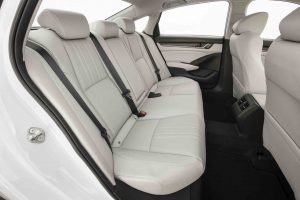
I am a 6ft 3 man and when sitting in the back seat – with the driver’s seat adjusted to accommodate a man my size – there was at least 8 inches of air between my knees and the back of the driver’s seat.
That is roomy.
Roomier, in fact – than a mid-sized (and $50k to start) Mercedes E-Class (36.3 inches) and only about 3 inches less than you’d get in a $100k to start (and full-sized) Mercedes S-Class sedan (43 inches).
A wider track and longer wheelbase (vs. last year) and shorter overhangs are responsible for the increase in cabin space. Thinner (by 20 percent) A pillars at either end of the windshield, moved rearward in relation to the position of the driver inside the cabin account for an increase in visibility.
All very functional.
But it also looks great.
The Accord has always been an attractive car, but the new one is sexy.
This is necessary – to draw back some of the people who drifted off the reservation and went Crossover. This gives them good reason to come back.
Honda touts the technology you can get in the new Accord – including a semi-automated steering system (LKAS) that uses electronic eyes to see the road and electric motors to nudge the car to the left or right as needed – to keep the car tracking true. This will not be everyone’s cup of tea, so you don’t have to buy it – and even if you do, it can be turned off at will.
There is also a traffic sign recognition system that knows the speed limit of the road you’re on – and advises you if you’re exceeding it. Here’s to hoping this technology is not used to advise the insurance mafia of it. 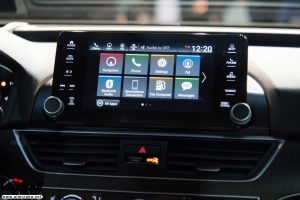
There is triple redundancy for the infotainment system. You can use the smartphone-style swipe/tap to change stations, for instance – or traditional knobs. Or buttons on the steering wheel.
Also on the wheel is a thumbwheel you can easily use to scroll through dashboard menu options – such as changing the display (it’s also LCD) to show the tachometer, or current fuel economy or any of several other functions. Motorcycles have a similar system and it makes as much sense in a car as on a bike. You can access info/change displays without taking your hand off the wheel – or your eyes off the road. 
Nits? Just two. And neither may be issues for you.
One, the sunroof isn’t a full-length panorama roof. Two, the passenger seat can’t be adjusted for height. One of my shorter friends noticed this – and mentioned it – so I thought I would, too.
THE BOTTOM LINE
Family sedans just got a lot more . . . interesting!
. . .
Got a question about cars – or anything else? Click on the “ask Eric” link and send ’em in!
If you like what you’ve found here, please consider supporting EPautos.
We depend on you to keep the wheels turning!
Our donate button is here.
If you prefer not to use PayPal, our mailing address is:
EPautos
721 Hummingbird Lane SE
Copper Hill, VA 24079
PS: EPautos magnets – they’re back! are free to those who send in $20 or more to support the site. Also, the eBook – free! – is available. Click here. Just enter you email in the box on the top of the main page and we’ll email you a copy instantly!




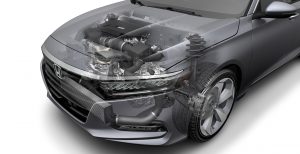
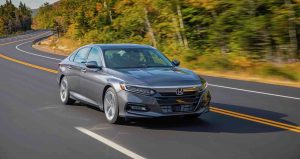

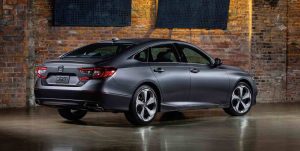
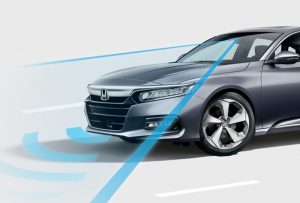







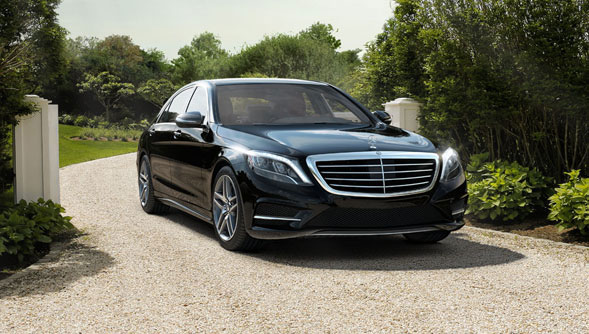
They give us turbos now for the sake of 2 mpg’s? Bye bye reliability and resale. Honda’s V6 is one of their best assets. So they throw that out the window. SIGH At least you can still get a V6 in an Acura. No turbo for me ever. There’s a reason turbos never became popular.
I don’t know if this foolishness has crossed over the pond so I’m going to investigate.
Big problems with gasoline dilution of the oil in the 1.5L turbo engine in the Civic.
Does the Accord use the same engine?
You’ve often made the point that a stick shift is just more “fun” than an automatic. Even when a modern automatic is both quicker and fuel efficient. That’s a subjective call, but obviously a valid opinion.
So let me ask you this…..are you saying that driving this small, turbo four, with performance in the same ballpark, is as much “fun” as the just retired Accord V-6??? Somehow, I doubt it.
The harmonics of flat fours are unappealing to many, whether in the Beetle or the new Cayman. Straight fours are less obnoxious, but seem to project a “sewing machine” aura. You can jazz them up with loud, fart can mufflers, but that’s totally juvenile.
The next step will be really tiny, turbocharged “threes.” And that’s when people will learn how bad engine harmonics can really get
It’s all probably inevitable. But few owners will call them any kind of “fun.”
Mike,
“The harmonics of flat fours are unappealing to many”.
There is no harmonics in a properly balanced flat four. The only noise I get from my “65 Bug is the sweet sound of two wide open 44mm IDF’s and the A1 sidewinder exhaust system!
Something that’s also good is the demise of the fingerprint collecting infotainment screen that used to be in there (and still is in most other Honda models). Whoever thought that a volume knob could be replaced by up/down touchscreen points that require you to take your eyes off the road to hit with your finger should have been chastised.